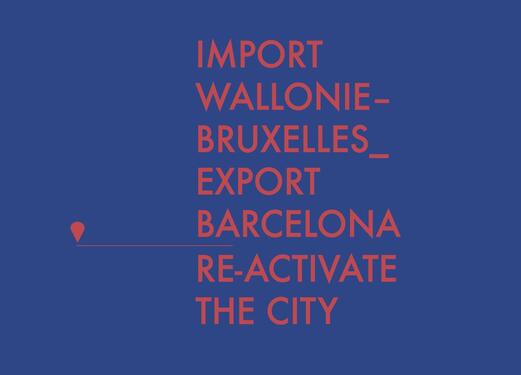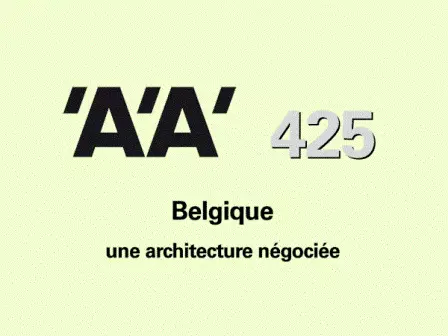- Posts
Published on 09/10/2018
Combining process and procedure

© WBA "The Belgian scene boasts a form of quality, humanism and poetry”, states issue no. 425 of Architecture d’Aujourd’hui, focusing on Belgian architecture. It must be said that over the last fifteen years, a spatial quality has sprung from architecture originating from Wallonia-Brussels in particular. This stems from an alliance between a specific architectural approach based on process and construction proficiency, and a pro-active architectural policy.
For the last thirty years, this project approach has been developed thanks to housing construction orders. This is of course the most widespread kind of order, as any self-respecting Belgian wants to build their own house - and to do so an architect is legally required, even if it only for a simple extension. Thip approach is thus user-centred and founded on the idea that we can “make do with”. We can make do with the current context, often synonym of low budgets, and of course make do with the future user. Talking about and analysing the order, questioning it, defining and refining it, and finally designing it based on proficient knowledge learnt in the finest Belgian Universities. Through all this it stays in the hands of the architect until final delivery. These support measures, regarding both the order and its commissioner and learnt through practice, served architects at the time when competitive calls were made mandatory by European bodies in 1993 for the completion of public works. A new kind of order thus appeared, surrounded by stuttering procedures. They felt (and sometimes still feel) more like the formulation of a question coupled with a (generally low) budget than a “standardised” competition, as established in Switzerland or France. Yet that lack of clarity is precisely where an architect’s ingenuity can insinuate itself. In supporting the creation of the order, the architect takes a handle on the project and only lets it go right at the very end. This approach, shared by several firms, means that contemporary architecture in Belgium is not a question of “style” or the result of “star architects”, but rather a precise, committed and single response to each order.
The downside is however palpable and cripples often small Belgian architectural firms. This upstream work is sometimes just too much, and is rarely recognised financially. “Making do with” thus becomes “making do despite” - which also results from a change in the construction context over the last fifteen years. “Doing” this form of architecture that stands strong and is proof of high quality “despite” low budgets, dealing with lots of standardised constraints, the lack of recognition for the architectural trade, the growing number of legal suits, etc.
Yet this approach and its result were soon valued and supported. This “architectural and spatial quality” has become a leitmotiv and even a fight for the last twenty-five years for certain people in the world of Belgian architecture. They made the most of competitive calls to introduce it. Heard by politicians, public bodies were born to help with public or private project ownership, required to formalise architecture service contracts. Each region and each community created its own structures: Vlaams Bouwmeester in Flanders (1999), Cellule Architecture in the Wallonia-Brussels Federation (2007), Bouwmeester-Maître Architecte in Brussels- Capital (2009). Some cities even wanted to establish this type of structure at their own small level, such as Antwerp (1999), Charleroi (2013) and Ghent (2017). These structures offer procedures founded mostly on quality criteria - such as habitability, urbanism, technical approach, etc. - placing the budget criterion in last position. They also banished anonymous competitions, to encourage competitive procedures with negotiations. Commissioners are now able to choose a project and project team.
Similarly, procedures for activating urban renovation - based on dialogue - are slowly emerging. They rely on this architectural approach that also meets current challenges aiming to reuse what already exists (structures, materials, etc.) - inherent to real estate in Belgian towns, where renovation is widely favoured and the “palimpsest” logic is key. The procedure for Sustainable district contracts thus appeared in 1994. These Contracts link the region of Brussels-Capital to its 19 surrounding communes, to fight the rise in unstable neighbourhoods and long administrative lead times regarding construction. A form of “acupuncture urbanism” was thus born, and among hundreds of others, the project acclaimed by the Emerging Architectural Prize Mies van der Rohe for 2017: the Navez Portaels social housing by the MSA and V+ firms.
This prize - as stated by Anna Ramos, Director of the Foundation - rewards “a heroic and ordinary approach”. An approach which all the projects presented in this exhibition Import WB _Export BCN. Re-activate the city can boast.
Par Audrey Contesse, architect, curator, critic and journalist.
- BilletsAuteur
Emmanuelle BornePublished on 06/07/2018
-
Belgitopie
Faut-il se fier aux expositions internationales, a fortiori à la Biennale d’architecture de Venise, pour appréhender les mouvements de fond et enjeux [...]
- BilletsAuteur
Xavier Lelion & Anne Sophie NottebaertPublished on 01/03/2018
-
Architecture Wallonie-Bruxelles.Inventaires, Quand la BD rencontre l'archi!
Depuis sa parution, le triple enjeu de la publication Inventaires est de relever, évaluer et rendre compte de l’architecture et de ses auteurs en [...]



